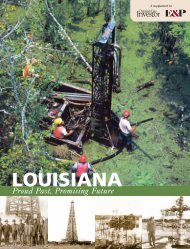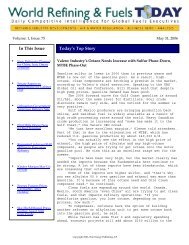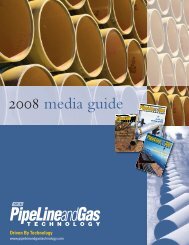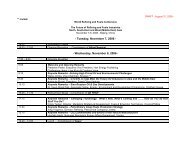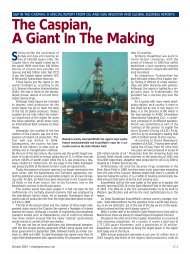ASTM: Gasoline Today and Tomorrow – An Executive Report
ASTM: Gasoline Today and Tomorrow – An Executive Report
ASTM: Gasoline Today and Tomorrow – An Executive Report
Create successful ePaper yourself
Turn your PDF publications into a flip-book with our unique Google optimized e-Paper software.
Octane Week | <strong>ASTM</strong>: <strong>Gasoline</strong> <strong>Today</strong> <strong>and</strong> <strong>Tomorrow</strong> - <strong>An</strong> <strong>Executive</strong> <strong>Report</strong><br />
<strong>ASTM</strong> Task Force Wrestles with Hydrogen Sulfide<br />
in Sample Quality Control Issue<br />
This story appeared on July 31, 2006.<br />
Because of sample stability concerns, the <strong>ASTM</strong>ʼs<br />
Silver Corrosion Task Force will delay a round robin<br />
of silver corrosion test methods <strong>and</strong> instead conduct a<br />
ruggedness study to see if a small sample set can be<br />
blended, shipped <strong>and</strong> tested. That decision, announced<br />
at the July 2006 D02.05.C Subcommittee meeting in<br />
Toronto, Ontario, Canada, might answer some critical<br />
questions but it sets back the timetable for finalizing<br />
a test method <strong>and</strong> adding it to D4814, a process<br />
subcommittee D02.A members had hoped to complete<br />
by the upcoming <strong>ASTM</strong> meeting in December.<br />
The decision to conduct a small ruggedness study<br />
stemmed from growing evidence that sample stability<br />
could not be controlled during the course of the round<br />
robin. That suspicion first emerged at the D02.05.C<br />
Subcommittee meeting last December, when round<br />
robin designers noted that some of the gasoline samples<br />
would contain hydrogen sulfide, which would oxidize<br />
over time, making it difficult, if not impossible to<br />
ensure that participating labs were sampling <strong>and</strong> testing<br />
the “same” material.<br />
Since then, Silver Corrosion Task Force Chairman<br />
Kevin Bly has probed the issue of hydrogen sulfide<br />
oxidation. “The problem is keeping the sample stable<br />
long enough to ensure all labs receive the same material<br />
in the Inter Laboratory Study,” Bly told the recent<br />
meeting. “How long can samples containing hydrogen<br />
sulfide be expected to be stable after preparation?”<br />
Knowing that, ILS designers could determine<br />
whether it would be possible to blend, package <strong>and</strong> ship<br />
samples, as well as have labs perform tests, within that<br />
timeframe.<br />
Blyʼs group considered an alternative strategy<br />
<strong>–</strong> excluding hydrogen sulfide as a blending component<br />
<strong>and</strong> replacing it with other active components that yield<br />
corrosion <strong>–</strong> but that was discounted.<br />
“We decided to keep hydrogen sulfide because<br />
thatʼs representative of whatʼs out there in the real<br />
world,” said Bly.<br />
Hydrogen sulfide is critical to the round robin, a<br />
task force member told Octane Week. “The species of<br />
interest is elemental sulfur, <strong>and</strong> hydrogen sulfide is the<br />
catalyst. Elemental sulfur on its own is not corrosive.<br />
There have been samples with very high levels of<br />
elemental sulfur, 20-30 ppm, <strong>and</strong> they still pass the test.<br />
Elemental sulfur needs to be activated.”<br />
<strong>An</strong>other alternative would be to prepare samples<br />
with varying levels of elemental sulfur <strong>and</strong> ship them<br />
to labs, where operators would add a fixed amount of<br />
hydrogen sulfide just prior to testing. This suggestion<br />
was appealing to the members at the meeting as a<br />
means to address the hydrogen sulfide stability issue,<br />
provided the appropriate guidance <strong>and</strong> procedure could<br />
be given to the labs to safely dose each sample with<br />
a fixed quantity of hydrogen sulfide. David Surette,<br />
Bob Falkiner <strong>and</strong> Weldon Cappel agreed to work as<br />
a separate Action Team to develop such a procedure<br />
that could subsequently be tested by several labs to<br />
determine suitability <strong>and</strong> address potential safety<br />
concerns involving the proper h<strong>and</strong>ling of hydrogen<br />
sulfide.<br />
To assess the stability of hydrogen sulfide in<br />
gasoline, the laboratory at Lyondell-Citgo prepared<br />
a blend of light cat cracked gasoline mixed with an<br />
untreated naphtha stream containing 30.8 ppm of<br />
hydrogen sulfide in liquid to yield a sample containing<br />
5.9 ppm of hydrogen sulfide. The material was split<br />
<strong>and</strong> stored in three separate quart bottles for analysis<br />
over a three week period. Samples were tightly closed<br />
<strong>and</strong> stored in a cold room. Each week for three weeks,<br />
a sample was tested along with the previous weekʼs<br />
sample to determine the corresponding hydrogen sulfide<br />
concentration. During that time, hydrogen sulfide levels<br />
dropped to 0. 8 ppm relative to the 5.9 ppm concentration<br />
in the original blend. In short, the conclusion was that<br />
maintaining a stable solution of hydrogen sulfide in a<br />
gasoline matrix would be difficult for more than a short<br />
period of time, less than one week.<br />
The decline in hydrogen sulfide was believed to<br />
be due to two main reasons. First, hydrogen sulfide<br />
might simply have escaped when the sample bottle<br />
was opened. Second, hydrogen sulfide can change<br />
chemically over time through polymerization to<br />
polysulfides, which tends to be more corrosive than<br />
hydrogen sulfide. Unfortunately, the hydrogen sulfide<br />
study did not include a sulfur (continued on p8)<br />
February 2007 7




